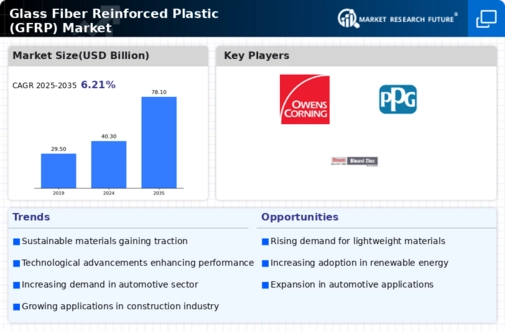Market Analysis
In-depth Analysis of Glass Fiber Reinforced Plastic GFRP Market Industry Landscape
The market dynamics of the Glass Fiber Reinforced Plastic (GFRP) industry are influenced by a variety of factors that shape supply, demand, and pricing trends. GFRP, also known as fiberglass reinforced plastic, is a composite material made of plastic reinforced with fine glass fibers. One of the key drivers of market dynamics is the increasing demand for lightweight and high-strength materials across various industries such as automotive, construction, aerospace, and marine. GFRP offers significant advantages over traditional materials like steel and aluminum, including corrosion resistance, high strength-to-weight ratio, and design flexibility.
From the market analysis you will note that the demand for high-quality glass fibers in the marine industry provides lucrative opportunities for the glass fiber reinforced plastic market(GFRP). During the assessment period, the GFRP replaced the primitive woods and steel building methods for manufacturing ships, yachts, and the vehicles used for marine transport. From the glass fiber reinforced plastic market trend increase in urbanization with expansion in wealth steers up the growth of the glass fiber reinforced market during the glass fiber reinforced plastic forecast period.
In recent years, the automotive industry has been a major contributor to the growth of the GFRP market. Automakers are increasingly incorporating GFRP components into vehicles to reduce weight and improve fuel efficiency. Additionally, stringent regulations aimed at reducing vehicle emissions have spurred the adoption of lightweight materials like GFRP. As a result, GFRP manufacturers are experiencing growing demand from automotive OEMs and suppliers.
The construction industry is another key driver of GFRP market dynamics. GFRP materials are being used in infrastructure projects such as bridges, tunnels, and buildings due to their durability, corrosion resistance, and low maintenance requirements. Moreover, GFRP composites offer architects and engineers greater design flexibility, enabling the construction of innovative and aesthetically pleasing structures. As urbanization continues to drive infrastructure development globally, the demand for GFRP in the construction sector is expected to remain strong.
In addition to end-user industries, technological advancements play a significant role in shaping the GFRP market dynamics. Innovations in manufacturing processes, such as automated fiber placement and resin infusion, have led to improvements in product quality, efficiency, and cost-effectiveness. These advancements have made GFRP more competitive with traditional materials and expanded its applicability in various industries.
On the supply side, the availability and cost of raw materials, particularly glass fibers and resins, influence market dynamics. Fluctuations in the prices of raw materials can impact the production costs of GFRP manufacturers and ultimately affect product pricing and profitability. Additionally, the presence of established players and new entrants in the market can affect competition and market dynamics. Established companies may have economies of scale and established customer relationships, while new entrants may bring innovation and disrupt the market with novel technologies or business models.
Market dynamics also encompass regulatory factors, such as environmental regulations and standards governing the use of composite materials. Compliance with regulations related to emissions, recycling, and waste disposal can influence the choice of materials and manufacturing processes used by GFRP manufacturers. Moreover, certifications and standards for quality, safety, and performance can affect market dynamics by influencing customer preferences and purchasing decisions.







Leave a Comment